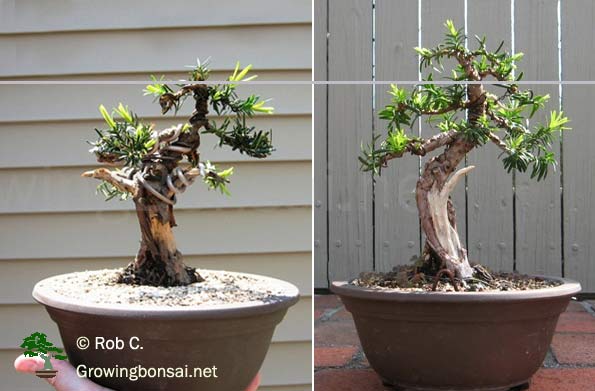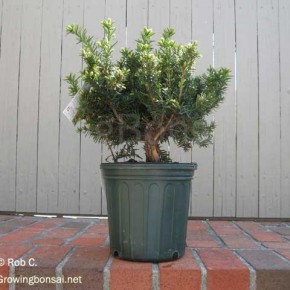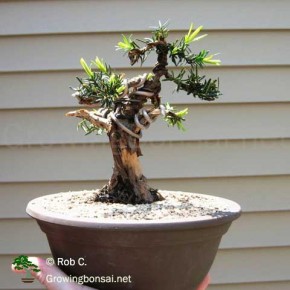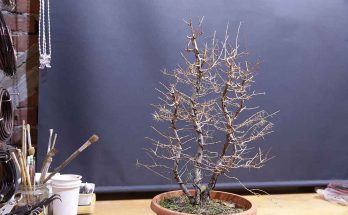Rob C. bought a nice little 30 U$D Taxus from a hardware store a few years ago. And after only 5 years or training, this has turned in a nice little Shohin with the making of a show-stealing bonsai.

The stock
In 2008 this little yew (Taxus spp) was purchased from a large home improvement chain (Home Depot). It was one of many, many of these little Taxus for sale, and not taken at random. Probably the most important step when working form garden centre plants: Be critical towards the plants basic properties. The roots should be properly placed, and the trunk should have desirable characteristics. Furthermore, there should be enough branches in good locations to work with. If you cannot find a plant with these basic elements, do not buy it.
The plant used here was hand-picked by the new owner, from a large number of similar trees. Selection criteria and attractive elements in the raw material were the presence of a well-establish natural jin on a nicely shaped and tapered trunk, a dense canopy with matured branches, and foliage all the way up to the trunk.
First styling
After taking the plant home, and looking at it from different angles, the plant was cut back by about 75%. Most branches were removed completely. One branch was jinned. Using protective tape, one of the main branches was wired down, and kept in place using a guy wire. (Bottom right)
Subsequent years
Several weeks later the plant was showing some fresh growth, an indication that some of the damage had been repaired and the plant was happily growing again. So, with the tree used to the reduced canopy, the tree was repotted into a nicer looking growth pot. This put is a lot bigger than ideal for a bonsai this size. It is however perfectly suited to let the tree develop fairly quickly, without the roots getting out of hand. At this time, also the lower right branch was removed. The original jin was reduced to a smaller stud, which gives a stronger impression of age.
Note that this is a lot of work applied to a plant in one growing season. Taxus is a hardy species and -particularly when young- takes a lot of abuse. A Chameacyparis, Juniperus, Pinus or Picea would not have survived such radical transformation in such short time. Unless you know the species you are working with really well, it is better to split above-ground and below-ground work over 2 years (Allow one growing season between treatments).
For the next year and a half the tree was left alone to grow. With regular application of fertilizer, this tree has grown well and the initial styling is fully overgrown. This is a normal procedure in order to thicken branches: you just let the foliage grow out. This gives strength to the roots, thickens branches and helps to heal the bark around jins and removed branches.
In springtime 2010 the new growth was removed. With a bit of work on the tree, cutting young growth back to the original branch structure produces a nice image of a young bonsai again. At this time it was also decided to remove the jin on the left to a very tiny stub, and create a new jin using the previously reduced branch on the right.
 When we look closely at the previous images, we can see how quick the development has gone. The gry line through both images roughly indicates the same position on the trunk: The tree has grown a full new canopy in just one and a half years! This is like it is often in bonsai: You may have to cut down a larger tree to make a bonsai. Sometimes, the tree is kept at that size. Sometimes however you need the tree to grow a whole new portion.
When we look closely at the previous images, we can see how quick the development has gone. The gry line through both images roughly indicates the same position on the trunk: The tree has grown a full new canopy in just one and a half years! This is like it is often in bonsai: You may have to cut down a larger tree to make a bonsai. Sometimes, the tree is kept at that size. Sometimes however you need the tree to grow a whole new portion.
Repotting into a bonsai pot (2011)
All this development work paid off, and within a few years from the purchase date the tree was ready to be placed in its first bonsai pot by 2011. Note that the pot is on the large side for a bonsai. The tree has a very thick below-ground trunk, filling most of the pot. Over the next few years the root ball will be reduced by cutting off a bit of the below-ground trunk, whenever the tree needs repotting. This forces the tree to create more roots on a shorter section of the below-ground trunk. The total reduction is to be carried out over several years. This reduces the impact on the health of the tree.
In early 2013 the tree has spent the last few months in winter storage. In fall 2012 the tree was left untrimmed, and now the spring thinning of foliage is carried out. Transforming what looks like a rough bush shaped like a bonsai, back into proper bonsai form.
The result, after 5 years of work

And there you have it. A true miniature tree, in just 5 years from a coarse hardware store plant!












Excellent work and a great inspiring story!!!
I just read you article when I searched for Yew bonsai. I just picked up one myself and your article gave me some great ideas. Since this is now 5 years old i am wondering if you have a recent picture of the Bonsai and how it’s doing.
Hi Bill, glad to hear this helped you!
Unfortunately, it was someone elses tree. SO I do not have any updates. 🙁
Hey there. Excellent. Thank you for doing this. Very helpful to see the progression. Just awesome.